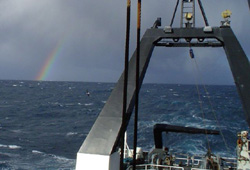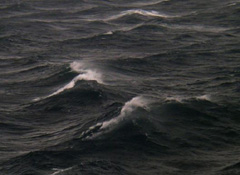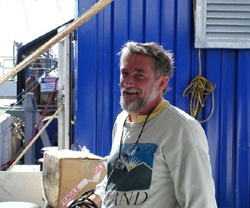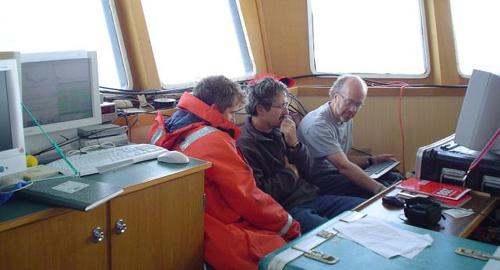Cruise
Log: Wednesday, March 24, 2004
|
March
|
|
Sun
|
Mon
|
Tue
|
Wed
|
Thu
|
Fri
|
Sat
|
|
|
1
|
2
|
3
|
4
|
5
|
6
|
|
7
|
8
|
9
|
10
|
11
|
12
|
13
|
|
14
|
15
|
16
|
17
|
18
|
19
|
|
|
|
|
|
24
|
|
|
|
|
|
|
|
|
|
|
|
|
April
|
|
|
|
|
|
|
|
|
|
|
|
|
|
|
|
|
|
|
|
|
|
|
16
|
17
|
|
18
|
19
|
20
|
21
|
22
|
23
|
24
|
|
25
|
26
|
27
|
28
|
29
|
30
|
|
|
 |
Even
under harsh conditions, there are moments of majesty and beauty (Photo
by Peter Minnett.
|
Contributor:
Peter Minnett
University of Miami
The day dawned dark and gray, and while not particularly foreboding, it
was not particularly promising either. The strong winds of yesterday abated
somewhat during the evening and night, but the swell persisted, rendering
attempts at sleep very difficult - more an exercise in trying to wedge yourself
in the bunk between naps than getting a refreshing sleep. However, as the
morning wore on, conditions improved as the winds and swell subsided and
eventually sunlight broke through. The weather has been very changeable
all day - once going from sunshine to horizontal hail to rain to sunshine
again all in the space of about 15 minutes. We have spent today doing a
more detailed survey of the study area to identify the optimal site for
the fertilizer injection. As well as underway measurements, CTD profiles
have been taken through the day. We look forward to "pumping iron"
tomorrow (and those of you who know me will recognize the irony in that
statement).
 |
 |
The
wind carrying spray from the crests of breaking waves (Photo by Craig
Stevens).
|
Contributor:
Peter J. Minnett, University of Miami (Photo by Brian Ward). |
 |
| Craig,
Murray and John examine the display of the NIWA radar used to measure
wave properties and breaking events upwind of the ship. The display
to the left is from the University of Miami's Marine-Atmospheric Emitted
Radiance Interferometer which is used to measure the ocean skin surface
temperature and lower atmosphere temperature (Photo by Peter Minnett). |
| |
| |
| |
| |
| |
| |
| |
| |
| |
| |
| |
The Physics Group
The objective of the physics group on board is to improve our understanding
of the physical factors that control the exchange of gases between the
ocean and atmosphere and that influence the growth of phytoplankton blooms.
This involves making very accurate measurements of the temperature of
the so-called skin-layer at the sea surface, as the solubility of gases
in sea water depends on temperature. We also measure the structure of
temperature, salinity, turbulence and light in the uppermost tens of meters
of the ocean, and the winds, temperature, humidity and turbulence in the
lowest layers of the atmosphere, as these control the exchange of gases
between the ocean and atmosphere, and influence the plankton growth. Also,
the behavior of the surface waves, especially as they break and inject
bubbles into the ocean, is being measured. All of this involves using
state-of-the art instruments in the very harsh marine environment, and
thus far, all signs are good for a valuable and unique set of measurements
to be made in the next three weeks. These topics will be discussed in
more detail in future bulletins. The physics group includes: Craig Stevens
(NIWA), Murray Smith (NIWA), John McGregor (NIWA), Edward Abraham (NIWA),
Brian Ward (Woods Hole Oceanographic Institution), and Peter Minnett (University
of Miami).
Next Day >>
|